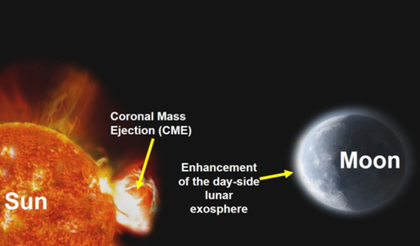ISRO’s Chandrayaan-2 detects solar impact on Moon’s atmosphere
By IANS | Updated: October 18, 2025 22:15 IST2025-10-18T22:13:31+5:302025-10-18T22:15:25+5:30
Bengaluru, Oct 18 In a landmark scientific breakthrough, the Indian Space Research Organisation (ISRO) announced that its lunar ...

ISRO’s Chandrayaan-2 detects solar impact on Moon’s atmosphere
Bengaluru, Oct 18 In a landmark scientific breakthrough, the Indian Space Research Organisation (ISRO) announced that its lunar orbiter Chandrayaan-2 has made the first-ever observation of the effects of Coronal Mass Ejections (CMEs) from the Sun on the Moon’s exosphere.
The observation was made using the Chandra’s Atmospheric Composition Explorer-2 (CHACE-2) instrument onboard the orbiter.
During a rare solar event on May 10, 2024, a series of CMEs impacted the Moon, leading to a significant increase in the total pressure of the dayside lunar exosphere — the extremely thin atmosphere surrounding the Moon.
ISRO scientists reported that the number density of neutral atoms and molecules in the exosphere increased by more than an order of magnitude, confirming theoretical predictions that had never before been validated through direct observation.
The Moon’s exosphere, classified as a surface boundary exosphere, is highly sensitive to solar activity due to the absence of a global magnetic field. The CME event enhanced the liberation of atoms from the lunar surface, temporarily altering the Moon’s atmospheric conditions.
ISRO said the findings not only deepen scientific understanding of lunar space weather but also have implications for future lunar missions and the design of human habitats on the Moon.
The study, titled “Impact of a Coronal Mass Ejection on the Lunar Exosphere as Observed by CHACE-2 on the Chandrayaan-2 Orbiter”, was published in Geophysical Research Letters on August 16, 2025.
"The Earth’s Moon has a very thin atmosphere, which falls under the category of ‘exosphere’, implying that the gas atoms and molecules in the lunar environment rarely interact despite their coexistence. The boundary of the exosphere is the surface of the Moon and hence the Moon’s exosphere falls under the category of ‘surface boundary exosphere’," ISRO said.
It said that Theexosphere on the Moon is produced by a number of processes, which involves the interaction of solar radiation,solar wind (ions of Hydrogen, Helium and a small quantity of heavier ions emanated from the Sun) and the impact of the meteorites with the surface of the Moon. These processes liberate atoms/molecules fromthe surface of the Moon, which become a part of the exosphere.
"In general, the exosphere of the Moon is highly sensitive to even small variations of the factors that are responsible for its creation, and such a factor is the emission of the coronal mass of the Sun, known as CME (short form of Coronal Mass Ejection). CMEs are events when the Sun ejects significant quantities of its building material, comprising mostly Helium and Hydrogen ions. These effects are significant on the Moon, as Moon is an airless body, that too deprived of any global magnetic field, the presence of which would have shielded (even partially) the solar effects on its surface," ISRO said.
It said that this opportunity to directly observe the effects of the CMEimpacting on the Moon came in a rare occurrence, on May 10, 2024, when a series of coronal mass ejections (CMEs) were hurled by the Sun. This increased quantity of the solar coronal mass that impacted on the Moon enhanced the process of knocking off the atoms from the lunar surface, thereby liberating them to the lunar exosphere, which manifested as the enhancement of the total pressure in the sunlit lunar exosphere.
"This observation would provide scientific insight in the understanding of the lunar exosphere and space weather effects on the Moon. Apart from pushing the edge of our scientific understanding about the Moon and the lunar space weather (effect of the Sun’s emissions on the Moon), this observation also indicates the challenges of building scientific bases on the Moon. Lunar base architects need to account for such extreme events, which would temporarily alter the lunar environment, before the effects subside." ISRO concluded.
Disclaimer: This post has been auto-published from an agency feed without any modifications to the text and has not been reviewed by an editor
Open in app